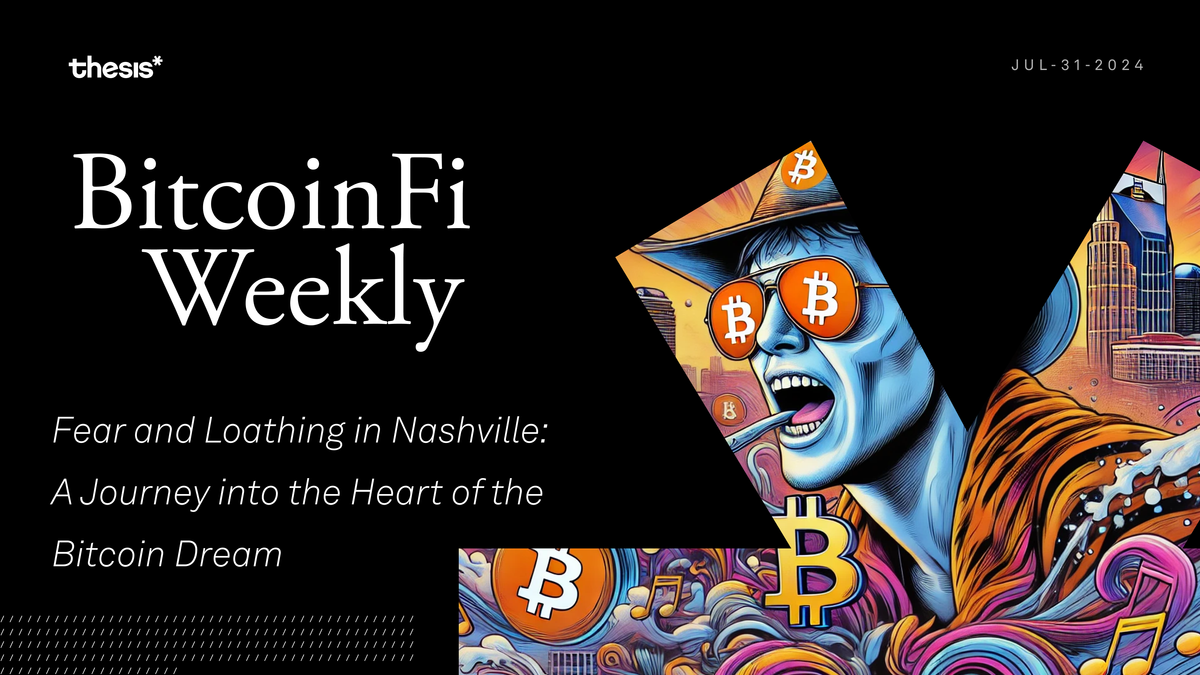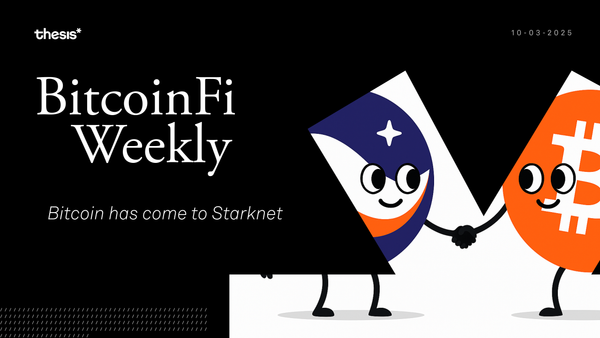Fear and Loathing in Nashville: A Journey into the Heart of the Bitcoin Dream
From zero-knowledge proofs pushing the boundaries of what's possible on-chain, to neo-banks like Fold bringing Bitcoin rewards to the masses, BitcoinFi is evolving at a dizzying pace.

Welcome to this week's edition of BitcoinFi Weekly, where we bring you the pulse of the Bitcoin ecosystem.
🚨 BitcoinFi Weekly Now on the Thesis Blog 🚨
We are excited to announce that BitcoinFi Weekly will now be hosted on the Thesis blog. This transition reflects our belief that the BitcoinFi Weekly should represent an agnostic, holistic view of the diverse and dynamic developments occurring across the broader Bitcoin landscape. With its decade-long experience in building all the components of the Bitcoin stack, we felt that Thesis is ideally positioned to offer this perspective. We look forward to continuing this journey with you from our new home at the Thesis blog.
July's end finds us catching our breath. In these thirty days, we've lived lifetimes. We've witnessed history in the making, and summer isn’t even over. Strap in.
Here’s this week’s rundown:
🇺🇸 BTC Nashville and Trump’s Dreams for Bitcoin
📉 Ordinal Inscriptions Fees Plummet
🚜 Acre Goes Live
🧠 Zero-Knowledge Proofs Have Arrived
🏦 Fold “BitcoinFi Neo-Bank” Goes Public
💰 HEX — the Newest BTC-backed Stablecoin
🚀 tBTC x GMX Update
Vamos.
Feature Piece: BTC Nashville Recap
For three sweltering days in July, Nashville transformed into a Bitcoin boomtown, trading honky-tonks for hash rates and cowboy boots for cold wallets. The 2024 Bitcoin Conference was the largest gathering in recent memory, making ETH Denver’s shindig look like a quaint barn dance in comparison.
The air crackled with an energy not seen since the early days of the cypherpunk movement. Gone were the tribal divisions and maximalist rhetoric of yesteryear. In their place stood a united front of innovators, from grizzled OGs to fresh-faced Layer 2 builders, all laser-focused on one goal: adoption. For the first time in a decade, Bitcoin is witnessing innovations deployed at pace with Ethereum. The conference floor buzzed with demos of Bitcoin-based zero-knowledge proofs, whispers of new staking protocols, and the unmistakable hum of opportunity—or perhaps that was just the Bitcoin mining rig powering a hot tub. Either way, The Bitcoin Renaissance is undeniably happening.
However, it was the political undercurrent that truly set this gathering apart. The day before Trump took the stage, Robert Kennedy Jr., scion of America's most storied political dynasty, lobbed a crypto bombshell of his own. With the casual air of a man suggesting a weekend getaway, RFK Jr. proposed an executive order to buy 550 Bitcoin daily until the U.S. holds a reserve of 4 million BTC if elected. As Donald Trump took the stage, promising a "strategic national Bitcoin stockpile," the crowd's reaction was electric. The idea wasn't new, of course, but the boldness of its presentation was unprecedented.
In the aftermath of Trump's bombastic address, something extraordinary happened. The political theater gave way to substance with startling speed. Senator Cynthia Lummis, a figure who'd mastered the art of straddling the worlds of Washington and Wyoming, stepped up to the podium with a genuine draft of the very bill Trump had alluded to in his speech, describing it as "our Louisiana Purchase moment.” It was the rarest of moments when a politician's grandiose claims crystallized into actionable policy before the applause had even died down. As Lummis detailed the bill, you could almost hear the gears of change grinding into motion. The energy in the room shifted palpably. The cynicism that often accompanies political promises evaporated, replaced by a cautious but visible optimism.
What became clear in that moment, and in the discussions that followed, was that Bitcoin had achieved something previously thought impossible in modern American politics: bipartisan appeal. Democrats and Republicans, often unable to agree on the color of the sky, are finding common ground in Bitcoin.
As the conference wound down, one thing was certain: the genie was out of the bottle. Bitcoin had made the leap from the fringes to the forefront of American politics, and there was no going back. The race to embrace the future of finance was on, and for once, D.C. wasn't just along for the ride—it was jockeying for the driver's seat.
Updates in BitcoinFi
Ordinals Inscriptions Fees Plummet to Shocking Lows
data source: https://dune.com/queries/2123547/3489157
The ordinals ecosystem has undergone significant changes since the introduction of runes, shifting focus away from its foundational culture. Recent data highlights a notable decline in activity. Originally, collectors prized low inscription numbers, appreciating the artistry, file size optimization, immutability, and rare sats. However, the landscape has shifted, with influencers now promoting specific ordinals for potential rune airdrops, inflating expectations. Nowadays, most newcomers are unaware of the earlier periods, removing essential elements of cultural continuity. Despite fees dropping to 3-4 sats/vB, daily inscription volumes have plateaued, with no day exceeding 75,000 inscriptions in over three months. This stagnation, even in a low-fee environment, may indicate a lack of stickiness, amongst other things...
Acre Goes Live
Acre is a core part of the BitcoinFi ecosystem and was announced live during BTC Nashville! At its core, Acre is a liquidity layer that operates across Bitcoin Layer 2 networks like Mezo. The platform's philosophy is rooted in Bitcoin principles, creating a "Bitcoin in, Bitcoin out" model where users stake BTC and receive BTC rewards. This approach contrasts centralized, permissioned models previously touted by now-defunct platforms like Celsius and BlockFi. The platform is open-source and built using tBTC, allowing permissionless withdrawals anytime.
Acre aims to provide a simple and transparent staking experience, avoiding the opaque models of centralized custody providers. Each BTC deposited mints stBTC, a liquid-staked token redeemable 1:1 for BTC, allowing users to remain liquid while earning rewards. When users deposit BTC with Acre, it validates L2 networks, generating rewards redeemable in BTC.
Acre has launched its Season 1, capped at 500 Bitcoin, giving early community members and followers a chance to participate. Depositors in Season 1 will immediately begin earning Acre Points and will be automatically approved for Season 2.
Zero-Knowledge Proofs Have Arrived
The fervor and excitement surrounding zero-knowledge proofs that dominated Ethereum's narrative throughout 2023 has finally found its way to Bitcoin. At the BTC Nashville, we witnessed the unveiling of multiple projects aimed at expanding Bitcoin's programmability and scalability through zero-knowledge proofs (SNARKs, to be specific). Two notable projects have emerged in this space: BitSNARK with its Grail implementation and Shinigami — a library enabling Bitcoin Script VM execution Cairo.
Following StarkWare's zk-proof test on Signet, BitcoinOS announced the first-ever verification of a zk-proof on Bitcoin's mainnet without a soft fork. This breakthrough builds on Robin Linus's BitVM concept, enabling Turing-complete smart contracts on Bitcoin. BitcoinOS demonstrated a UTXO containing both Bitcoin and an Ordinal, controlled by a zero-knowledge smart contract, effectively emulating covenant functionality without protocol changes. Their whitepaper introduces BitSNARK, an optimized system for "Bitcoin rollup bridges," and Grail, its practical implementation.
BitSNARK simplifies BitVM, reducing instructions to ADD, SUB, and MULBIT, eliminating RAM consistency checks, and streamlining the verification protocol. These optimizations significantly improve (up to 50%) program size and efficiency for bridge-related computations. Grail introduces a multi-operator model and efficient deposit and withdrawal processes and uses zkSNARK Groth16 proofs for transaction inclusion and state verification.
Adding to this exciting landscape is Shinigami, a library enabling Bitcoin Script VM execution in Cairo. Shinigami allows for the generation of STARK proofs of generic Bitcoin Script computation, opening up possibilities for proving and verifying Bitcoin block headers consensus rules and script execution. This could have implications for improving Initial Block Download processes and reducing trust assumptions in bridges and atomic swaps.
This convergence of security, scalability, and programmability is clearly indicative of the larger motif: the Bitcoin Renaissance is here.
Fold, the first BitcoinFi Neo-Bank, Goes Public via SPAC
Fold, a Thesis portfolio company, is set to become the first pureplay financial services company powered by Bitcoin to go public. As an essential component of Thesis's Full Bitcoin Stack, Fold offers a unique neo-banking experience that bridges the gap between traditional finance and the Bitcoin ecosystem. Its flagship product allows users to earn 1.5% back in Bitcoin on bill payments and everyday transactions, making it an ideal onboarding platform for crypto novices and veterans. With over 1,000 bitcoin in its corporate treasury, Fold offers market-leading bitcoin cashback debit cards, merchant rewards, integrated insured bitcoin custody, and no-fee trading. The company's Bitcoin rewards now extend to bill payments, including mortgages, rent, and credit card bills. The company's public listing represents a huge milestone in the mainstream adoption of Bitcoin financial services, offering investors exposure to a business model that directly benefits from the growing Bitcoin economy.
Let’s talk about bill pay with @fold_app pic.twitter.com/vrcnk4N4eS
— Brian Harrington (@BrainHarrington) July 8, 2024
BitLen Introduces HEX, a BTC-backed stablecoin
HEX emerges as the first BTC-pegged stablecoin designed to enhance stability, accessibility, and yield generation. Developed by the BitLen team, HEX introduces a unique three-token system comprising LEN (governance), pHEX (BTC-pegged stablecoin), and yHEX (yield-bearing token).
source: HEX Whitepaper
The yield is primarily generated through Bitcoin staking, utilizing two main methods. First, HEX leverages native staking solutions, which are extensions of Bitcoin Improvement Proposals (BIPs) 65 and 420. Second, it aggregates existing third-party staking protocols, including side chains and BTC layers such as Core, Bsquare, Babylon, and BounceBit.
tBTC Officially Coming to a GMX Market Near You
Following up on last week's newsletter, tBTC's integration on GMX has been officially confirmed. This decision follows the initial proposal from Threshold Network and a thorough risk assessment conducted by Chaos Labs. The approved market will be a tBTC-only market for trading BTC, similar to the successful single-token wBTC markets previously implemented.BitcoinFi only expands and accelerates.
Closing Thoughts
As the high from Nashville fades, one can't help but feel we're standing at the precipice of something monumental. From zero-knowledge proofs pushing the boundaries of what's possible on-chain, to neo-banks like Fold bringing Bitcoin rewards to the masses, BitcoinFi is evolving at a dizzying pace. Yet, amidst this whirlwind of innovation, there's a sure-dogged sense that we've only, barely, just scratched the surface.
Thank you for tuning in to this week’s BitcoinFi Weekly. See you next week.
If there's a topic you’d like us to cover or have questions, reach out at [email protected].
Learn more about Thesis and our Full Bitcoin Stack at the following channels:
👾 Discord: https://discord.mezo.org & https://discord.com/invite/acre
🖥 Website: https://thesis.co/
🏦 Deposit Portal: https://mezo.org/hodl & https://stake.acre.fi/





